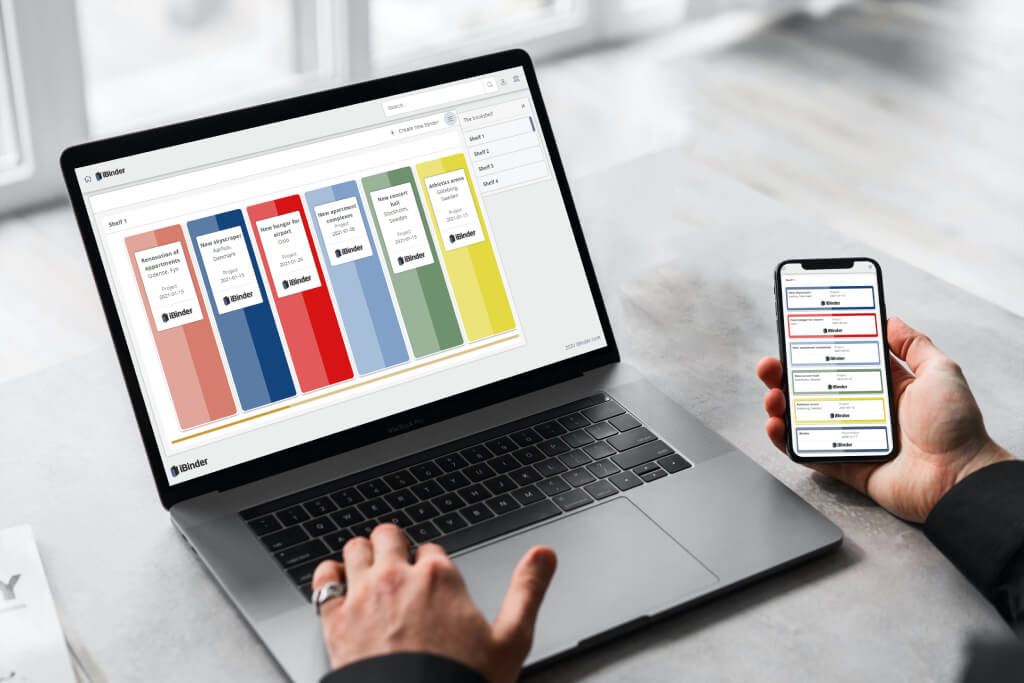Efficient construction processes with flexible case management
Managing construction projects involves many tasks that need to be coordinated, followed up on, and completed on time. Here, case management plays an important role—not just for keeping track, but for creating structure, clarity, and flow. With the right system support, it becomes easier to adapt processes to the needs of the project while also increasing efficiency. Our experts Rikard (Product) and Johan (Support) explain how the feature creates value in practice.

New features in case management
Now you can work smarter with:
- New Views – List, Kanban & Gantt
- Custom Workflows & Fields
- Drag-and-Drop, Emojis & Built-in Instructions
- Quick File Linking, Start Dates & Improved Excel Import
Faster. Clearer. More flexible than ever.
What is Case Management?
Rikard: Case management in iBinder is a feature used to organize and track tasks that are time-sensitive and assigned to a responsible user. A case serves as the primary carrier of information and can be displayed in different views depending on its purpose.
Johan: Thanks to the flexibility of the system, case management can be used for everything from task tracking to checklists. The feature also allows cases to be assigned to project participants and provides a clear overview of all ongoing cases within a project.
Why Are We Doing This at iBinder?
Rikard: Combining document management and case management on a single platform reduces the risk of information loss and increases project transparency. When all information is gathered in one place, it's easy to follow the status of cases and understand their context. With all users accessing the same up-to-date documents and data, decisions can be made accurately and in a timely manner.
Real-time updates to case status offer a shared, current view of the project status, strengthening collaboration across teams.
Johan: iBinder’s solution also enables customers to establish a clear and efficient structure for various workflows. Rather than relying on manual tools like Excel, users gain tailored functionality that enhances visibility, control, and traceability in their work.
What Is It Used For? What Is the Purpose of This Feature?
Rikard: The main benefit is enhanced collaboration. All stakeholders can view and interact with the same documents and cases in real time, significantly improving efficiency. The visual board serves as a reference before, during, and after meetings, providing a shared understanding of the current situation. This reduces misunderstandings and ensures important tasks aren’t overlooked between meetings.
Johan: The feature also enables the assignment of cases within, for example, a construction project, where each participant can clearly see their responsibilities. Communication and follow-up occur directly within each case, eliminating the need for external tools like email for case-related dialogue.
Why is iBinder’s Case Management Better Than Excel, Checklists, or Similar Tools?
- No versioning issues: Because everything happens in real time within a shared digital environment, there's no risk of someone working on the wrong document version or editing the wrong row. Everyone always sees the same updated information.
- Automatic notifications: When a case is assigned or reassigned, the responsible person is notified via email. This ensures no tasks are missed and communication is clear and traceable.
- Improved structure and overview: Unlike Excel, which can quickly become cluttered and hard to navigate, iBinder's interface offers a clear overview of all active cases. Responsible users immediately see what’s expected of them.
- Flexible multi-process handling: Multiple workflows can run in parallel within the same project binder, organized in separate tabs with custom permissions. This ensures clarity and security—no unauthorized access to information.
What’s the Difference Between a Checklist and Case Management?
Checklists and case management are two predefined workflows in iBinder. They are based on the same underlying functionality but tailored to different task types.
The key difference is the status flow:
- Checklist includes three stages: To Do, In Progress, and Done, suitable for simpler tasks that don’t require review.
- Case Management includes four stages: Evaluate, To Do, For Review, and Approved, offering more control for tasks that require evaluation and approval before completion.
All statuses appear as columns in a Kanban board, where cases can easily be moved between steps.
Both workflows support categorization for sorting and filtering. Categories can be added as free text or selected from predefined lists, making it easy to adapt the structure to the needs of each project.
How Do I Customize Case Management to Suit My Needs?
Rikard: Customizing iBinder’s case management is easy and flexible. You can create as many workflows as needed and use them across different organizational binders. Each workflow can be tailored with custom status stages—named and defined by you. You also determine what fields a case should include, such as text fields, dates, users, or predefined dropdowns.
Johan: This ensures that the information collected matches the specific needs of the project. Customization is usually done through process templates in the organization's binder. These templates define the data structure for each case, including required fields and status stages—both in terms of quantity and naming. This enables a consistent and effective workflow regardless of project size or complexity.
Concrete Use Cases
Worksite Planning
Ensure clear responsibility and execution clarity
Johan: Case management helps plan and organize the worksite in a structured way. Start by defining the tasks as cases and categorize them by type, area, or responsibility. Then assign each case to the appropriate person with clear start and end dates. This provides visibility, accountability, and a solid timeline for execution.

Deviation Management
Document, track, and prevent construction errors
Johan: Each error or deviation can be registered as its own case. Assign it to the responsible party and specify how it impacts the timeline. By setting start and end dates, you create a timeline showing when issues were reported and when they should be resolved. This supports structured follow-up and helps prevent similar errors in the future.

Can I Attach External Files, Use Multiple Tabs, and Filter Information in Case Management?
Johan: Yes. You can attach both external files and existing documents from the project binder. You can also work with multiple tabs within the same project, making it easier to structure different workflows. Additionally, you can filter information by status, assignee, category, or date—no matter which view mode you’re using.
The benefits of using iBinder at an early stage
-
Offers easy and seamless transitions between the phases of construction projects, for example from early stages to design and then production.
-
If you have a lot of projects currently ongoing, you can see which ones are in each phase of the construction process; early stage, design, production, warranty phase, etc.
-
Information management for the project is kept together right from the start, instead of being scattered across various emails and different cloud storage systems. The history is clear, which is particularly important in long projects.
-
In iBinder it is easy to upload, review and show BIM models directly in your binders. You can view the entire BIM model or limit it to specific areas.
-
Documents and information are linked to communication, so it is easy to see which users have accessed and seen what.

How iBinder works
iBinder is a cloud-based platform that helps the construction and real estate industry better manage information and documentation about their properties.

